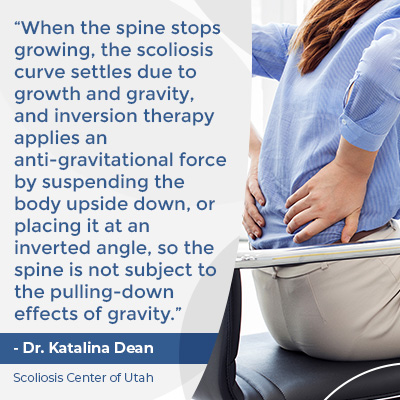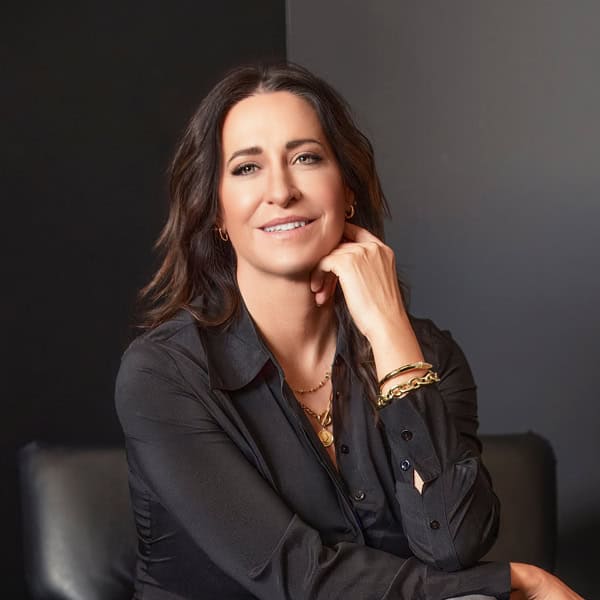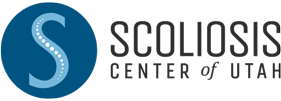Blogs
Scoliosis Inversion Therapy: Benefits Explained

Inversion therapy involves being upside down, or at an inverted angle; the anti-gravitational effect can decompress the spine, open up space within the spine, increase spinal flexibility, and relieve pressure on the spine and its surrounding muscles and nerve roots.
Inversion therapy can’t treat scoliosis, but it may help with scoliosis pain relief and make the spine more responsive to treatment. A primary cause of scoliosis pain is compression, and being inverted can relieve compression by easing pressure on the spine and its surroundings.
While inversion therapy can’t alter the position of the spine, it can offer a number of therapeutic benefits, including relieving pressure for pain relief.
Scoliosis Pain
Scoliosis causes an unnatural sideways-bending spinal curvature to develop, and as the spine also rotates, scoliosis is 3-dimensional.
Scoliosis is also progressive, meaning its nature is to become more severe over time, and it’s growth that triggers progression.
Progression will involve the size and rotation of the unhealthy spinal curvature increasing, and its effects will become more noticeable.
Not all scoliosis patients experience pain; no two cases are the same. There are many factors that shape a patient’s experience of scoliosis, including patient age, condition type, severity, location within the spine, and the angle of rotation.
A main cause of scoliosis pain is compression (uneven pressure), and patient age is a key factor, and as a progression condition, scoliosis is unlikely to stay the same, particularly during periods of growth.
Scoliosis affects all ages but is most commonly diagnosed in children, and the most prevalent type overall is adolescent idiopathic scoliosis.
When it comes to pain caused by compression, patient age is important.
Compression and Scoliosis Pain
Scoliosis becomes compressive once skeletal maturity is reached, so young patients who are still growing don’t commonly experience compressive pain, but can experience varying degrees of muscle pain.
When the spine is growing, a constant lengthening motion is occurring, and this counteracts the compressive force of the scoliosis, but once growth stops, there is nowhere for that uneven pressure to go, and it commonly causes back pain, muscle pain, and nerve pain.
Back Pain
Localized back pain can develop in the main spinal section affected due to the spine’s misalignment, and as the spine’s surrounding muscles help support and stabilize the spine, they can also be affected by the unnatural spinal curve.
Most back pain is felt in the section of the spine with the scoliosis, but it can also be felt in other areas of the back, particularly with compensatory curves; in some cases of scoliosis, when the spine loses a single healthy curve, the spine responds by adding a compensatory curve elsewhere in the spine in an attempt to counteract the initial curve’s uneven forces.
Muscle Pain
A muscular imbalance is a common effect of scoliosis as the back muscles are pulled in different directions; they try to counteract the spine’s unnatural bend and twist.
If muscles on one side of the spine are working harder to try and support the spine, they will become stronger, while muscles on the opposite side that are underused become weaker, and this can cause muscle spasms and muscle pain.
Radiating Nerve Pain
Scoliosis can also cause nerve compression, which can be particularly painful.
The spine contains 31 pairs of spinal nerves that make up the spinal cord, and these nerves work with the brain to form the central nervous system: a vast communication network that facilitates communication between the brain and body.
If the spine is compressed, its nerves within, and where they exit the spine, can also experience compression, making them inflamed, irritated, and/or impinged, and this can cause a wide range of symptoms and varying levels of pain.
Nerve pain can radiate far from its source of origin; a compressed spinal nerve commonly causes pain in the extremities.
When it comes to scoliosis pain, this is a symptom, and inversion therapy is a potential resource for providing short-term pain relief.
Inversion Therapy
While no type of therapy, including inversion therapy, should be attempted without prior approval from a scoliosis patient’s treatment provider, it can offer some therapeutic benefits.
There are only three instances where the spine isn’t subject to gravitational forces: in the womb, in water, and in space.
 When the spine stops growing, the scoliosis curve settles due to growth and gravity, and inversion therapy applies an anti-gravitational force by suspending the body upside down, or placing it at an inverted angle, so the spine is not subject to the pulling-down effects of gravity.
When the spine stops growing, the scoliosis curve settles due to growth and gravity, and inversion therapy applies an anti-gravitational force by suspending the body upside down, or placing it at an inverted angle, so the spine is not subject to the pulling-down effects of gravity.
When the spine is inverted, space is opened up within, relieving pressure from its individual vertebral bodies, structures (intervertebral discs), muscles, and nerves, and this can provide temporary pain relief.
Taking pressure off the discs of the spine can also improve circulation in the area, and as the discs don’t have their own vascular supply, this is important for disc health and restoration.
Issues caused by degenerative disc disease such as a bulging and/or herniated disc can contribute to the development of scoliosis, particularly degenerative scoliosis, and be painful; disc health shapes overall spinal health.
So can inversion therapy treat scoliosis? No, inversion therapy doesn’t have the power to alter the spine’s position and/or rotation, but it can help with symptom management and treatment responsiveness.
Inversion Therapy Benefits for Scoliosis Patients
In cases where inversion therapy is deemed appropriate, it can have a number of therapeutic benefits for scoliosis patients.
As scoliosis progresses, the spine becomes increasingly rigid, and this can cause back pain and makes the spine less responsive to treatment.
In fact, in some scoliosis cases where patients have progressed significantly prior to starting treatment, the spine’s rigidity needs to be addressed in order for patients to be able to perform scoliosis-specific therapeutic exercises.
 Inversion therapy can help maintain spinal flexibility, making it more responsive to nonsurgical treatment, particularly scoliosis-specific chiropractic care that may involve manual adjustments working towards improving the spine’s alignment.
Inversion therapy can help maintain spinal flexibility, making it more responsive to nonsurgical treatment, particularly scoliosis-specific chiropractic care that may involve manual adjustments working towards improving the spine’s alignment.
Increasing the spine’s flexibility makes it more responsive to treatment and improves the patient’s ability to perform key therapeutic exercises as part of treatment.
Inversion therapy can also help take pressure off the spine’s surrounding muscles and nerves, relieve strained and tight muscles, and reduce pressure on compressed discs and nerves.
Taking pressure off the spine improves pain, posture, and movement. When people are experiencing back pain, unhealthy posture and movement patterns can develop.
So inversion therapy can help scoliosis patients, but it affects scoliosis more indirectly than directly, in terms of treatment efficacy and symptom management.
Pain is a symptom of scoliosis, so pain relief is about symptom management, but for sustainable long-term pain relief, the underlying cause of the pain has to be addressed: the structural misalignment of the spine.
Conclusion
Scoliosis is a complex condition, which is why here at the Scoliosis Center of Utah, every patient is comprehensively assessed so treatment plans can be fully customized.
Scoliosis causes the spine to bend unnaturally to the side and rotate, and a spine that doesn’t have its natural curves in place is one that’s misaligned and off-balance.
The spine’s balance and stability needs to be restored, and there are a number of different facets of treatment and therapies that work towards improving the spine’s health and the health of its surroundings.
The Center’s nonsurgical scoliosis treatment combines Chiropractic BioPhysics®, a scoliosis-specific exercise program, and corrective bracing.
ScoliBalance® uses the power of scoliosis-specific exercise to strengthen and balance the spine’s surrounding muscles for more support, while using mirror image exercises to teach postural awareness for long-term improvement.
The ScoliBrace® also works towards improving the body’s 3-dimensional posture and the spine’s alignment, and because it’s designed with movement in mind, it complements the ScoliBalance® program.
Scoliosis-specific chiropractic care can involve a number of techniques such as manual adjustments, and inversion therapy, when deemed beneficial, can help with increasing spinal flexibility, blood flow around the discs, and taking pressure off the spine and its surroundings for pain relief.
While inversion therapy can help scoliosis patients in terms of short-term pain relief, it can’t improve the spine’s position, alignment, and rotation, so isn’t an effective scoliosis treatment option.

Dr. Katalina Dean
Dr. Katalina Dean is the founder and clinical director of Scoliosis Center of Utah, in Midvale, UT. Her team specializes in posture correction, spinal rehabilitation, and non-invasive scoliosis care and bracing.
Call Today
Do You Qualify for Care?
Schedule an Appointment Below
